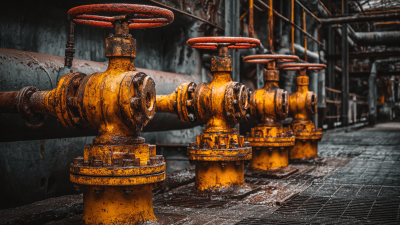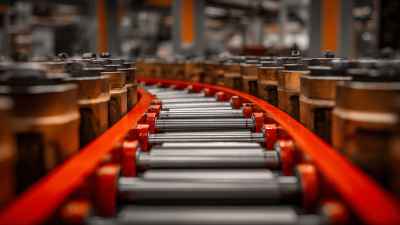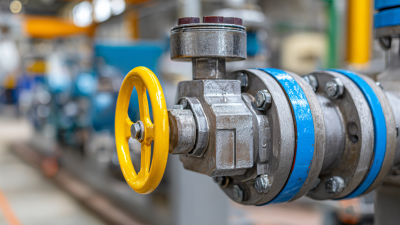
In industrial applications, the choice of valves plays a crucial role in ensuring efficient fluid control and system performance. Among the various types of valves, gate valves stand out due to their unique design and functionality. According to a report by Global Market Insights, the industrial valve market is expected to surpass $85 billion by 2025, with gate valves accounting for a significant share due to their reliability and ability to handle high-pressure environments. Gate valves are particularly favored in applications requiring minimal pressure drop, making them ideal for on/off services in pipelines. Understanding the strengths and limitations of gate valves compared to other valve types, such as ball valves and globe valves, is essential for engineers and decision-makers in optimizing their systems for maximum efficiency and cost-effectiveness. This guide aims to provide a comprehensive comparison of gate valves and their alternatives, helping professionals make informed choices in the evolving landscape of industrial applications.

In industrial applications, selecting the right valve type is crucial for ensuring system efficiency and safety. Gate valves are often favored for their low resistance to fluid flow, making them ideal for on/off control in high flow applications. Unlike globe valves, which are designed for throttling services and feature a greater pressure drop due to their design, gate valves provide a straight-through pathway that minimizes turbulence. According to recent data from the Valve Manufacturers Association, gate valves are preferred in 62% of large-scale industrial projects where fluid control is critical.
Conversely, ball valves, known for their quick operation—often requiring just a quarter turn to open or close—are commonly utilized in situations requiring fast shutoff capabilities. Their durability and tight sealing properties make them suitable for high-pressure systems, as highlighted in a report by the American National Standards Institute, which emphasizes their reliability in preventing leaks. While gate valves can be advantageous for throttling, they lack the efficiency of ball valves in rapid response scenarios, particularly in processes that involve frequent switching. Therefore, the choice between gate, globe, and ball valves is highly dependent on the specific operational requirements and fluid dynamics in industrial settings.

When it comes to industrial applications, selecting the right valve type is crucial for operational efficiency. Among the various options available, butterfly valves stand out due to their unique design and versatility. Unlike gate valves, which provide on/off control and can create significant pressure drops, butterfly valves allow for a more compact solution with a lower flow resistance. This makes them ideal for controlling the flow of liquids and gases in pipelines, minimizing energy consumption while maintaining optimal performance.
One of the key advantages of butterfly valves is their ease of operation. They can be quickly opened or closed with a quarter turn, making them suitable for applications where rapid flow regulation is necessary. Additionally, their lightweight construction reduces the overall burden on supporting structures, facilitating easier installation and maintenance. With a wide range of materials and designs available, including resilient seated and high-performance options, butterfly valves can be tailored to meet specific industry requirements, making them a viable alternative to traditional gate valves in various settings.

In the realm of industrial applications, check valves play a crucial role in maintaining system integrity and safety. These valves, designed to allow flow in one direction while preventing backflow, are essential for protecting equipment from damage and ensuring operational efficiency. Their ability to respond automatically to changes in pressure can significantly enhance the reliability of various systems, making them indispensable in industries ranging from oil and gas to food processing.
As the mobile directional control valve market experiences substantial growth—projected to rise from $350 million in 2022 to $580 million by 2030—check valves increasingly find their place in this evolving landscape. With a compound annual growth rate of 7.5% expected from 2024 to 2030, the demand for robust, efficient valve solutions continues to grow. This trend underscores the versatility of check valves in adapting to the needs of modern industrial systems, offering benefits such as reduced maintenance costs and improved performance efficiency, which are vital for businesses striving to optimize operations in a competitive market.
Safety and pressure relieving valves are vital components in industrial process systems, acting as the last line of defense against overpressure scenarios. These valves are designed to open automatically when the pressure exceeds a predetermined limit, thereby preventing potential damage to equipment, loss of materials, and most importantly, safeguarding human life. In environments such as chemical manufacturing, oil refineries, and power generation, the risks associated with excessive pressure can lead to catastrophic failures if not properly managed. Therefore, understanding the operational characteristics and maintenance needs of these valves is crucial for ensuring overall system safety.
Moreover, the integration of safety and pressure relieving valves into industrial applications is not just a regulatory requirement; it’s a strategic approach to risk management. These valves must be compatible with the specific media they control, which affects their material selection and overall performance. Regular testing and maintenance schedules for these valves are essential to uphold their reliability and effectiveness. As industries continue to innovate and expand, prioritizing safety features like relieving valves will become increasingly important to prevent incidents that could result in serious consequences. The proactive management of these safety devices can significantly enhance the operational integrity of process systems.
In industrial applications, selecting the right valve type is crucial for efficiency and safety. Diaphragm valves and pinch valves serve specific roles, particularly in handling corrosive fluids or slurries. Diaphragm valves are ideal for applications requiring a leak-proof seal and minimal contamination. According to a 2022 industry report from MarketsandMarkets, the global diaphragm valve market is expected to reach $3.68 billion by 2026, reflecting its increasing adoption in the pharmaceutical and water treatment sectors.
Pinch valves, on the other hand, excel in handling highly viscous fluids and bulk materials. They operate by pinching the flexible tube closed, which provides excellent flow control. A recent study by Grand View Research estimates that the pinch valve market will see substantial growth, projected to reach $864 million by 2028. Their low maintenance requirements and simplicity make them a cost-effective choice in various industries, particularly in mining and food processing.
Tip: When considering diaphragm or pinch valves, evaluate the nature of the fluid and the required flow control precision. It's essential to consult industry standards and guidelines to ensure that the selected valve meets operational safety and efficiency requirements. Moreover, routine maintenance checks can help in prolonging the lifespan of these specialty valves.





